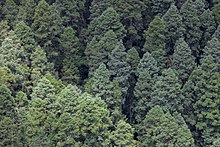Abies religiosa, the oyamel fir or sacred fir,[4] (known as oyamel in Spanish) is a fir native to the mountains of central and southern Mexico (Trans-Mexican Volcanic Belt, Sierra Madre del Sur) and western Guatemala. It grows at high elevations of 2,100–4,100 metres (6,900–13,500 ft) in cloud forests with cool, humid summers and dry winters in most of its habitat regime. In the state of Veracruz, it grows with precipitation all year long. The tree is resistant to regular winter snowfalls.
| Abies religiosa | |
|---|---|

| |
| Sacred fir forest at El Chico National Park in Hidalgo, Mexico | |
| Scientific classification | |
| Kingdom: | Plantae |
| Clade: | Tracheophytes |
| Clade: | Gymnospermae |
| Division: | Pinophyta |
| Class: | Pinopsida |
| Order: | Pinales |
| Family: | Pinaceae |
| Genus: | Abies |
| Species: | A. religiosa
|
| Binomial name | |
| Abies religiosa | |
| Synonyms[3] | |
| |
Names
editThe Spanish name oyamel comes from the Nahuatl word oyametl (oya, "to thresh"; metl, "agave"; literally "threshing agave"). It is also called árbol de Navidad (Christmas tree) in Mexico. The English name derives from the binomial Abies religiosa, literally "religious fir". This comes from the use of its cut foliage in religious festivals (notably at Christmas) and in churches in Mexico.[5]
Description
editAbies religiosa is a medium-sized to large evergreen coniferous tree growing to 25–50 m (82–164 ft) tall with a trunk diameter of up to 2 metres (6.6 ft). The leaves are needle-like, flattened, 1.5–3.5 cm (0.59–1.38 in) long and 1.5 mm (0.059 in) wide by 0.5 mm (0.020 in) thick, dark green above, and with two blue-white bands of stomata below; the leaf apex is acute. The leaf arrangement is spiral on the shoot, but with each leaf variably twisted at the base so they lie flat to either side of and above the shoot, with none below the shoot. The shoots are reddish-brown, hairless or with scattered pubescence.
The cones are 8–16 cm (3.1–6.3 in) long and 4–6 cm (1.6–2.4 in) broad, dark blue-purple before maturity; the scale bracts are purple or greenish, of moderate length, with the tips exposed in the closed cone. The winged seeds are released when the cones disintegrate at maturity about 7–9 months after pollination. Trees from the western end of the range on Nevado de Colima, Jalisco have cones with larger, reflexed bract scales (similar to noble fir cones); these are sometimes treated as a separate species, Abies colimensis.
Significance
editThe sacred fir is the preferred tree for the monarch butterfly (Danaus plexippus) to reside in colonies during its hibernation in the forests of the Trans-Mexican Volcanic Belt. Although monarch butterflies are known in other parts of the southern Mexican highlands as some specimens do not migrate, the bulk of them gather in a few protected fir forests in the Monarch Butterfly Biosphere Reserve near the towns of Angangueo (Michoacán) and Avándaro (State of Mexico), from December to March.
The wood of the sacred fir is rather soft and thus not very suited for woodworking. Nonetheless, its distribution is decreasing because of logging for fuel and other human-related disturbances.[6]
A 2012 paper by Cuauhtemoc Saenz-Romero among others, published in Forest Ecology and Management found that "the area suitable for the oyamel is likely to diminish by 96 percent by 2090, and disappear completely within the [Monarch Butterfly Biosphere] reserve."[7][8]
Gallery
edit-
Detail of leaves and male cones
-
Chincua sanctuary, the Monarch Butterfly Biosphere Reserve
-
El Rosario sanctuary, the Monarch Butterfly Biosphere Reserve
-
In the Sierra Norte, Oaxaca
-
Piedra Herrada butterfly sanctuary, Mexico
References
edit- ^ Farjon, A. (2013). "Abies religiosa". IUCN Red List of Threatened Species. 2013: e.T39592A2929657. doi:10.2305/IUCN.UK.2013-1.RLTS.T39592A2929657.en. Retrieved 19 November 2021.
- ^ "Abies religiosa". Germplasm Resources Information Network. Agricultural Research Service, United States Department of Agriculture. Retrieved 2009-10-22.
- ^ The Plant List
- ^ "Abies religiosa". The Encyclopedia of Life.
- ^ Timbers of the New World. Arno Press. 1943. p. 13. ISBN 9780405028069.
The specific epithet (religiosa) refers to the common use of the evergreen branches for decorations in churches.
- ^ "Oyamel (Abies religiosa)" (PDF). CONABIO. Retrieved 2016-08-30.[permanent dead link]
- ^ Linthicum, Kate (April 13, 2019). "Mexican scientists move forest to save butterflies". Los Angeles Times. Retrieved January 5, 2020.
- ^ René I. Alfaroa; Bruno Fady; Giovanni Giuseppe Vendramin; Ian K. Dawson; Richard A. Fleming; Cuauhtémoc Sáenz-Romero; Roberto A. Lindig-Cisneros; Trevor Murdock; Barbara Vinceti; Carlos Manuel Navarro; Tore Skrøppa; Giulia Baldinelli; Yousry A. El-Kassaby; Judy Loo (1 December 2014). "The role of forest genetic resources in responding to biotic and abiotic factors in the context of anthropogenic climate change". Forest Ecology and Management. 333: 76–87. doi:10.1016/j.foreco.2014.04.006.
- Liu, T. S. (11 November 1971). A Monograph of the genus Abies. National Taiwan University.
